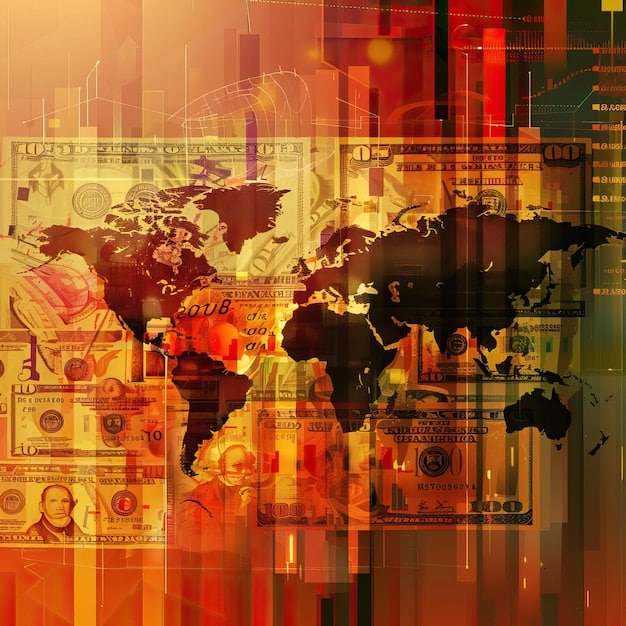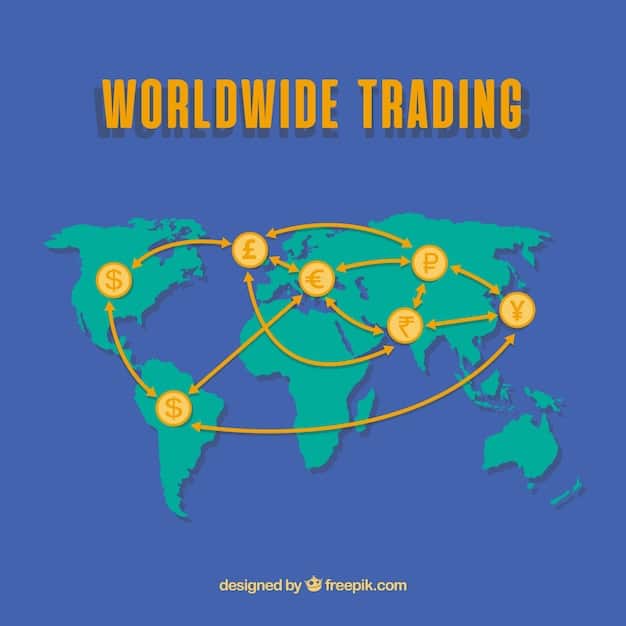US Dollar Strength: Impact on Global Trade & Investment

The strength of the US Dollar significantly reshapes global economic dynamics, influencing trade balances, commodity prices, inward and outward investments, and financial market stability across international borders.
The US dollar, often considered the world’s primary reserve currency, holds immense power. Its fluctuations resonate far beyond American shores, directly impacting international trade, capital flows, and the financial health of nations worldwide. Understanding the intricate dance between the dollar’s value and the global economy is not just for economists but for anyone involved in international business or investing.
Understanding the Pillars of US Dollar Strength
The US dollar’s status as the global reserve currency is not accidental. It’s built on a foundation of several key factors, ranging from economic stability to geopolitical influence. These pillars provide the bedrock for its perceived safety and liquidity, attracting investors from around the world, especially during times of uncertainty.
One primary driver is the sheer size and dynamism of the American economy. As the largest economy globally, the US offers a vast consumer market and a diverse industrial base, making it an attractive destination for foreign direct investment. This economic gravity inherently strengthens its currency.
Monetary Policy and Interest Rate Differentials
The Federal Reserve’s monetary policy plays a pivotal role in dictating the dollar’s strength. When the Fed raises interest rates, it makes dollar-denominated assets, like US Treasury bonds, more attractive to foreign investors. This increased demand for dollars to invest in these assets drives up its value.
- Interest Rate Hikes: Generally lead to a stronger dollar by drawing capital seeking higher returns.
- Quantitative Tightening: A strategy where the Fed reduces its balance sheet, effectively withdrawing liquidity from the market, which can also bolster the dollar.
- Inflation Control: A Fed committed to controlling inflation enhances the dollar’s purchasing power and long-term stability.
Conversely, a dovish monetary policy or lower interest rates can make other currencies more appealing, leading to dollar depreciation. The differential in interest rates between the US and other major economies is a constant gravitational pull for foreign capital.
Geopolitical Stability and Safe-Haven Status
In times of global crisis or geopolitical tension, the US dollar typically assumes a “safe-haven” status. Investors flock to perceived safer assets, and the dollar, backed by the US government’s stability and robust legal framework, is often the first choice. This flight to safety creates significant demand for the dollar, pushing its value higher even when economic fundamentals might suggest otherwise.
The dollar’s role in global trade and finance also provides inherent stability. Most international transactions, particularly those involving commodities like oil, are priced in dollars. This pervasive use creates a constant demand for the currency, further cementing its strength.

Impact on International Trade: Winners and Losers
A strong US dollar has a complex and often contradictory impact on international trade. While it bestows purchasing power upon American consumers and businesses importing goods, it simultaneously creates headwinds for US exporters and makes goods from other nations more competitive.
Consider the perspective of American importers: a strong dollar means they can purchase more foreign goods and services for the same amount of US currency. This translates to lower import costs, which can benefit consumers through cheaper products and companies through reduced input expenses. Industries heavily reliant on imported raw materials or components often thrive when the dollar is strong.
Challenges for US Exporters
For US exporters, a strong dollar presents a significant challenge. Their products become more expensive for foreign buyers using weaker currencies. This can lead to a decrease in demand for American goods and services abroad, potentially reducing export volumes and revenue. Industries from manufacturing to agriculture can feel this pinch directly. A company selling machinery overseas, for instance, might see its competitiveness eroded if the dollar gains 10% against the euro or yuan.
- Reduced Competitiveness: US products are more expensive for foreign buyers.
- Lower Export Volumes: Decreased demand leads to fewer goods shipped internationally.
- Shrinking Profit Margins: Exporters may have to lower prices in dollar terms to remain competitive, impacting profitability.
This dynamic often contributes to trade deficits in the United States, as imports become more attractive and exports less so. While cheaper imports can help control domestic inflation, a sustained period of dollar strength can harm export-oriented sectors and lead to job losses in those industries.
Beneficiaries in Other Nations
Conversely, nations whose currencies weaken against the dollar stand to benefit from increased export competitiveness. Their products become cheaper and more attractive to US consumers and businesses. This can provide a significant boost to their export sectors, stimulating economic growth and job creation.
Economies heavily reliant on exports, particularly those to the US market, often welcome a stronger dollar from their perspective. However, they also face the challenge of more expensive dollar-denominated imports, such as oil and commodities, which can fuel domestic inflation.
Investment Implications: Capital Flows and Asset Valuation
The strength of the US dollar profoundly influences international investment flows, dictating where capital moves and how assets are valued globally. Its impact is felt across various investment classes, from stocks and bonds to real estate and commodities.
When the dollar strengthens, it often signals a “flight to safety” or greater confidence in the US economy. This makes dollar-denominated assets more appealing to foreign investors. For example, US Treasury bonds, already considered among the safest investments globally, become even more attractive when their yields are combined with a strengthening currency, providing a double benefit to international buyers.
Attracting Foreign Direct Investment (FDI)
A strong dollar can encourage foreign direct investment into the United States. Overseas companies find it cheaper to acquire US assets, such as factories, real estate, or entire businesses, as their local currency can purchase more dollars. This influx of FDI can stimulate economic growth, create jobs, and foster technological advancements within the US.
However, it also makes it more expensive for US companies to invest abroad. Acquiring foreign businesses or expanding operations in other countries becomes costlier in dollar terms, potentially slowing the global expansion of American corporations.
Impact on Corporate Earnings and Debt
US multinational corporations with significant overseas operations often see their foreign earnings diminish when the dollar strengthens. Profits earned in weaker foreign currencies translate into fewer dollars when repatriated, affecting the company’s bottom line. Conversely, a strong dollar can make foreign currency debt cheaper to service for US companies that have borrowed internationally.
For foreign companies with dollar-denominated debt, a strong dollar is a serious concern. The cost of servicing that debt rises in their local currency, potentially leading to financial stress and even defaults, especially in emerging markets. This dynamic can trigger capital outflows from these economies as investors become nervous about their financial stability.
Commodity Prices and the Dollar’s Influence
The relationship between the US dollar and commodity prices is inverse and particularly significant. Most major commodities—oil, gold, copper, and agricultural products—are priced and traded globally in US dollars. This dollar-denomination creates a direct link between the currency’s value and the cost of these essential resources.
When the US dollar strengthens, it takes fewer dollars to buy a given amount of a commodity, making that commodity cheaper for holders of other currencies. This often leads to a decrease in demand from international buyers, pushing down commodity prices. Conversely, a weakening dollar makes commodities more expensive in other currencies, generally increasing their dollar price.
Energy and Food Costs
This dynamic is especially critical for energy and food prices. A strong dollar can translate to lower oil prices, benefiting oil-importing nations and consumers through reduced fuel costs. However, it negatively impacts oil-exporting nations, whose revenues decrease in their local currencies.
- Strong Dollar, Lower Oil Prices: Good for importers, challenging for exporters.
- Weak Dollar, Higher Oil Prices: Good for exporters, challenging for importers.
For food, a strong dollar can make imported food cheaper for US consumers, but it can also make American agricultural exports more expensive for foreign buyers, affecting the global food supply chain and prices. The interplay here is complex and often feels like a zero-sum game, with winners and losers on different sides of the global trade equation.
Geopolitical and Economic Implications Beyond Trade
The strength of the US dollar reaches far beyond immediate trade and investment figures, weaving into the fabric of geopolitical relationships, economic stability in developing nations, and the overall global financial architecture. Understanding these broader implications is crucial for a complete picture.
Developed nations, while still impacted by dollar strength, often have more robust economies and diversified trade relationships to absorb the shocks. Their central banks typically have more tools at their disposal to mitigate adverse effects. However, for emerging markets and developing economies, a strong dollar can pose significant challenges.
Debt Burden and Financial Stability in Emerging Markets
Many developing countries have substantial amounts of dollar-denominated debt. When the US dollar strengthens, the burden of servicing and repaying these debts in their local currencies increases significantly. This can lead to financial distress, raise the risk of sovereign defaults, and force governments to implement austerity measures, which can stifle economic growth and lead to social unrest.
Furthermore, a strong dollar often leads to capital outflows from emerging markets as investors seek safer, higher-yielding opportunities in dollar-denominated assets. This can destabilize their financial markets, weaken their currencies further, and restrict their access to international capital, creating a vicious cycle of economic contraction.
Influence on Global Economic Policy and Diplomacy
The dollar’s dominance grants the United States significant leverage in international economic and political affairs. Sanctions imposed by the US, for instance, are particularly potent because they can limit access to the dollar-based global financial system. This power can be used to achieve foreign policy objectives but also carries the risk of backlash and efforts by other nations to de-dollarize their trade and financial systems.
Nations may seek alternative payment systems or currencies to reduce their reliance on the dollar, although establishing viable alternatives to the established global system is a monumental task. The discussions around a multi-polar currency world gain traction during periods of prolonged dollar strength, reflecting a desire for greater financial autonomy among nations.
Navigating the Strong Dollar Environment: Strategies for Businesses and Nations
Operating in an environment of a strong US dollar requires carefully considered strategies from both businesses and sovereign nations. Adapting to these currency dynamics can mean the difference between thriving and struggling in the global marketplace.
For businesses, particularly those engaged in international trade, hedging strategies become paramount. Companies that export goods from the US might consider currency hedging to lock in exchange rates, protecting their revenues from adverse dollar appreciation. Importers, on the other hand, might benefit from a strong dollar by purchasing more goods, but they also need to be mindful of potential currency reversals.
Diversification and Financial Prudence
Nations, especially those with significant dollar-denominated debt, must prioritize prudent financial management. This includes managing their foreign currency reserves effectively, exploring ways to reduce reliance on dollar-denominated borrowing, and fostering robust domestic economic policies that can withstand external shocks.
- Boost Domestic Demand: Reduce reliance on exports by strengthening the internal economy.
- Diversify Trade Partners: Seek new markets to mitigate risks associated with currency fluctuations in primary trading partners.
- Build Foreign Reserves: Maintain adequate reserves to buffer against capital outflows and currency depreciation.
Economies that rely heavily on commodity exports need to be particularly vigilant. A strong dollar can significantly reduce their export revenues, impacting government budgets and development projects. Diversifying their economies away from over-reliance on a single commodity can offer greater resilience.
For central banks around the world, managing their currency’s response to a strong dollar involves a delicate balancing act. They must weigh the benefits of increased export competitiveness against the inflationary pressures of more expensive dollar-denominated imports. Intervention in currency markets or adjustments to domestic interest rates are common tools, but they carry their own set of risks and consequences. Ultimately, navigating a strong dollar environment demands foresight, adaptability, and an understanding of interconnected global financial systems.
Businesses that have a global footprint need to continuously monitor exchange rates and integrate currency risk management into their core financial planning. Supply chain diversification can also help mitigate the impact of localized currency shocks.

| Key Aspect | Brief Description |
|---|---|
| 📈 Trade Impact | US exports become more expensive, imports cheaper; affects competitiveness. |
| 💰 Investment Shifts | Attracts FDI to US, increases foreign dollar-debt burden for other nations. |
| ⛽ Commodity Prices | Generally lowers dollar-denominated prices for raw materials like oil. |
| 🛡️ Safe-Haven Status | Dollar strengthens during global uncertainty, attracting capital. |
Frequently Asked Questions About US Dollar Strength
▼
The US Dollar strengthens due to several factors, including higher US interest rates relative to other countries, its safe-haven status during global instability, strong economic growth in the US, and its role as the primary global reserve currency for trade and finance.
▼
A strong dollar makes US exports more expensive for foreign buyers using weaker currencies. This can reduce demand for American goods and services abroad, leading to lower export volumes and potentially impacting the profitability of US exporting companies across various sectors.
▼
Yes, typically. Most major commodities (like oil and gold) are priced in US dollars. A stronger dollar means it takes fewer dollars to buy a commodity, which can push down their dollar-denominated prices, making them cheaper for those using other currencies.
▼
For foreign countries, especially emerging markets, with dollar-denominated debt, a strong dollar increases the cost of servicing and repaying that debt in their local currency. This can lead to financial strain, currency crises, and potentially hinder economic development and stability.
▼
A strong dollar tends to attract foreign direct investment (FDI) into the US, as foreign companies can acquire American assets more cheaply. However, it also makes it more expensive for US companies to invest abroad, potentially slowing their international expansion efforts.
Conclusion: Adapting to the Dollar’s Enduring Influence
The strength of the US dollar is a multifaceted phenomenon with profound and far-reaching implications for international trade and investment. Its status as the global reserve currency, underpinned by the stability of the US economy and strategic Fed policies, ensures its continued dominance. While a strong dollar can offer benefits in terms of purchasing power for American consumers and attractive investment opportunities within the US, it simultaneously creates headwinds for US exporters and places significant financial pressure on nations with dollar-denominated debt. Understanding these dynamics is not merely an academic exercise; it’s a practical necessity for businesses, investors, and policymakers navigating the complex currents of the global economy. As the world continues to evolve, adapting to the dollar’s enduring influence will remain a key factor in shaping economic success and stability across borders.





